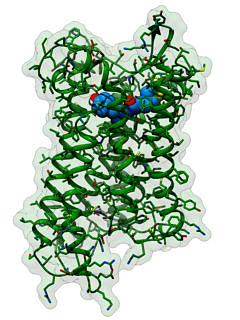Pain reliever without side effects

International team of researchers develops a new pain reliever which does not cause dependency or respiratory failure
An international team of researchers including involvement from Friedrich-Alexander-Universität Erlangen-Nürnberg has developed a new opioid pain reliever with a characteristic of special significance: the new analgesic appears to have virtually no serious side effects. The active ingredient has been successfully tested in model experiments to date. The researchers’ findings were recently published in the renowned journal Nature.
http://dx.doi.org/10.1038/nature19112
Opiates belong to the most important medications: they are used to relieve intense pain, making them an invaluable resource for society. However they also have serious side effects. Every year thousands of people die due to addiction and respiratory failure resulting from opiate use. For that reason pharmaceutical chemists around the world have been conducting research for many years on the development of new analgesics which do not exhibit these adverse effects.
Previous studies have been limited so far to the optimisation of classic opiates. An international team of researchers from FAU, Stanford University, University of California San Francisco (UCSF) and the University of North Carolina (UNC) recently developed a completely new pain reliever. The researchers succeeded in demonstrating in a model experiment that their new active ingredient PZM21, which has no chemical similarity to conventional opiates, is as effective as morphine in relieving pain. Evidence of respiratory depression, i.e. slowed breathing, and dependency could not be found. In the course of future research, the active ingredient will be studied further to determine whether similarly positive results could also be obtained for human use.
International teamwork
In order to develop this drug the researchers used the newly discovered structure of the μ-opioid receptor, the most important activation site for strong opioid-based analgesics, which was discovered by the team of Nobel laureate and Stanford professor Brian Kobilka, together with FAU professor Peter Gmeiner, Division of Medicinal Chemistry (press release: www.fau.eu/2015/08/11/news/receptor-shown-in-3d/); both are currently closely involved in the most recent research.
Using the docking method, the research group of UCSF professor Brian Shoichet used a high-performance computer to identify which of the more than three million potential active ingredients would be best suited to interact with the μ-opioid receptors. This yielded 23 molecules, which were subsequently investigated by the research group of University of North Carolina professor Bryan Roth to examine their receptor binding behaviour and thus identify the most promising candidates.
While strong drugs activate receptors in nanomolar concentrations – approximately the concentration of a sugar cube dissolved in a swimming pool – the matches from computer-supported docking processes only recognise their receptors in micromolar concentrations. For this reason, the FAU research group of Professor Gmeiner changed the molecular structure in order to significantly increase its potency. Their experiments ultimately led to the highly active drug molecule PZM21.
A functionally selective drug
‘Interestingly, PZM21 is a functionally selective drug. It is able to activate G proteins which interact with the receptor, but not the signal molecule ß-arrestin, which is responsible for the typical opioid side effects,’ explained Gmeiner. Doctoral candidate Daniela Dengler and postdoctoral researchers Viachaslau Bernat, Stefan Löber, Harald Hübner and Ralf Kling also succeeded in finding the binding site of PZM21 on the receptor by investigating structure-activity relationships and using molecular dynamics simulations – a significant finding for transferring the principle of functional selectivity to other pharmaceutically relevant G protein-coupled receptors. Their objective is also the development of new drug candidates without side effects.
Diverse investigations by the pharmacological research groups ultimately yielded the desired results, both in vitro and in animal models: strong pain-relieving characteristics without signs of respiratory failure or behaviours characteristic for dependency and virtually without signs of constipation, another side effect from which pain patients often suffer.
Also researching: Nobel laureate Kobilka from Stanford University
‘This promising approach to a new medication was made possible by a very intensive, interdisciplinary, intercontinental combination of computer-based drug screening, pharmaceutical chemistry and comprehensive pre-clinical studies,’ said Nobel laureate Kobilka of Stanford University. ‘If even just one of these links had been missing, it wouldn’t have worked. Without Kobilka’s structure, our computations, Roth’s pharmacology and Gmeiner’s ability to put an atom exactly where it needs to be, this discovery never would have been possible,’ added Professor Brian Shoichet, professor for pharmaceutical chemistry at UCSF. ‘This international group of researchers definitely has the potential to answer other fundamental questions in pharmaceutical research,’ concluded Professor Peter Gmeiner.
For the drug to actually reach the market as a medication, many extensive experiments and clinical studies are still needed. Professor Gmeiner and his colleagues have jointly founded the company Epiodyne Inc. to continue the development of PZM21 – or a drug derived from it – as a potential pain reliever with limited side effects.
Further information:
Prof. Dr. Peter Gmeiner
Phone: +49 9131 8524116
peter.gmeiner@fau.de